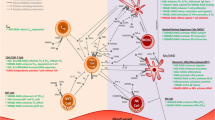Abstract:
Receptor for AGE (RAGE) is a member of the immunoglobulin superfamily that engages distinct classes of ligands. The biology of RAGE is driven by the settings in which these ligands accumulate, such as diabetes, inflammation, neurodegenerative disorders and tumors. In this review, we discuss the context of each of these classes of ligands, including advance glycation endproducts, amyloid β peptide and the family of β sheet fibrils, S100/calgranulins and amphoterin. Implications for the role of these ligands interacting with RAGE in homeostasis and disease will be considered.
Similar content being viewed by others
Author information
Authors and Affiliations
Additional information
Received 2 January 2002; accepted 30 January 2002
Rights and permissions
About this article
Cite this article
Bucciarelli, L., Wendt, T., Rong, L. et al. RAGE is a multiligand receptor of the immunoglobulin superfamily: implications for homeostasis and chronic disease. CMLS, Cell. Mol. Life Sci. 59, 1117–1128 (2002). https://doi.org/10.1007/s00018-002-8491-x
Issue Date:
DOI: https://doi.org/10.1007/s00018-002-8491-x




